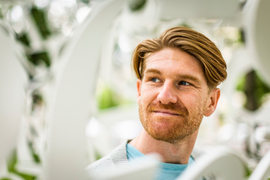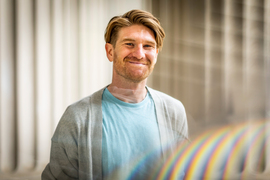After three years leading biking tours through U.S. National Parks, Jackson Jewett decided it was time for a change.
“It was a lot of fun, but I realized I missed buildings,” says Jewett. “I really wanted to be a part of that industry, learn more about it, and reconnect with my roots in the built environment.”
Jewett grew up in California in what he describes as a “very creative household.”
“I remember making very elaborate Halloween costumes with my parents, making fun dioramas for school projects, and building forts in the backyard, that kind of thing,” Jewett explains.
Both of his parents have backgrounds in design; his mother studied art in college and his father is a practicing architect. From a young age, Jewett was interested in following in his father’s footsteps. But when he arrived at the University of California at Berkeley in the midst of the 2009 housing crash, it didn’t seem like the right time. Jewett graduated with a degree in cognitive science and a minor in history of architecture. And even as he led tours through Yellowstone, the Grand Canyon, and other parks, buildings were in the back of his mind.
It wasn’t just the built environment that Jewett was missing. He also longed for the rigor and structure of an academic environment.
Jewett arrived at MIT in 2017, initially only planning on completing the master’s program in civil and environmental engineering. It was then that he first met Josephine Carstensen, a newly hired lecturer in the department. Jewett was interested in Carstensen’s work on “topology optimization,” which uses algorithms to design structures that can achieve their performance requirements while using only a limited amount of material. He was particularly interested in applying this approach to concrete design, and he collaborated with Carstensen to help demonstrate its viability.
After earning his master’s, Jewett spent a year and a half as a structural engineer in New York City. But when Carstensen was hired as a professor, she reached out to Jewett about joining her lab as a PhD student. He was ready for another change.
Now in the third year of his PhD program, Jewett’s dissertation work builds upon his master’s thesis to further refine algorithms that can design building-scale concrete structures that use less material, which would help lower carbon emissions from the construction industry. It is estimated that the concrete industry alone is responsible for 8 percent of global carbon emissions, so any efforts to reduce that number could help in the fight against climate change.
Implementing new ideas
Topology optimization is a small field, with the bulk of the prior work being computational without any experimental verification. The work Jewett completed for his master’s thesis was just the start of a long learning process.
“I do feel like I’m just getting to the part where I can start implementing my own ideas without as much support as I’ve needed in the past,” says Jewett. “In the last couple of months, I’ve been working on a reinforced concrete optimization algorithm that I hope will be the cornerstone of my thesis.”
The process of fine-tuning a generative algorithm is slow going, particularly when tackling a multifaceted problem.
“It can take days or usually weeks to take a step toward making it work as an entire integrated system,” says Jewett. “The days when that breakthrough happens and I can see the algorithm converging on a solution that makes sense — those are really exciting moments.”
By harnessing computational power, Jewett is searching for materially efficient components that can be used to make up structures such as bridges or buildings. These are other constraints to consider as well, particularly ensuring that the cost of manufacturing isn’t too high. Having worked in the industry before starting the PhD program, Jewett has an eye toward doing work that can be feasibly implemented.
Inspiring others
When Jewett first visited MIT campus, he was drawn in by the collaborative environment of the institute and the students’ drive to learn. Now, he’s a part of that process as a teaching assistant and a supervisor in the Undergraduate Research Opportunities Program.
Working as a teaching assistant isn’t a requirement for Jewett’s program, but it’s been one of his favorite parts of his time at MIT.
“The MIT undergrads are so gifted and just constantly impress me,” says Jewett. “Being able to teach, especially in the context of what MIT values is a lot of fun. And I learn, too. My coding practices have gotten so much better since working with undergrads here.”
Jewett’s experiences have inspired him to pursue a career in academia after the completion of his program, which he expects to complete in the spring of 2025. But he’s making sure to take care of himself along the way. He still finds time to plan cycling trips with his friends and has gotten into running ever since moving to Boston. So far, he’s completed two marathons.
“It’s so inspiring to be in a place where so many good ideas are just bouncing back and forth all over campus,” says Jewett. “And on most days, I remember that and it inspires me. But it’s also the case that academics is hard, PhD programs are hard, and MIT — there’s pressure being here, and sometimes that pressure can feel like it’s working against you.”
Jewett is grateful for the mental health resources that MIT provides students. While he says it can be imperfect, it’s been a crucial part of his journey.
“My PhD thesis will be done in 2025, but the work won’t be done. The time horizon of when these things need to be implemented is relatively short if we want to make an impact before global temperatures have already risen too high. My PhD research will be developing a framework for how that could be done with concrete construction, but I’d like to keep thinking about other materials and construction methods even after this project is finished.”













